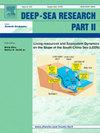皇子海山链蛇科——多样性、分布与生物地理学
IF 3
3区 地球科学
Q2 OCEANOGRAPHY
Deep-sea Research Part Ii-topical Studies in Oceanography
Pub Date : 2025-07-25
DOI:10.1016/j.dsr2.2025.105523
引用次数: 0
摘要
本文介绍了黄帝海底山链(ESC)海蛇尾的分布特征、垂直分布特征、生物地理特征和大型底栖生物群落优势度。这项研究是基于收集了100多个样本的工作结果,并分析了R/V Akademik Lavrentyev(2019年和2021年)使用ROV Comanche 18进行的两次探险中获得的70多个小时的视频材料。目前已鉴定出蛇总纲17科21属29种,并揭示了它们与ESC上不同类型基质(含粉砂和下伏岩石露头的砂质沉积物、凝固熔岩和岩底)的关系。在不同海山上发现的优势种为蛇麻、蛇麻、细纹蛇麻、麻麻、细纹蛇麻、黄纹蛇麻、黄纹蛇麻。ESC底栖生物中含有大量的海蛇尾类群,是群落的优势或重要组成部分。不同的海蛇尾分类群与特定的底物类型之间存在相关性。由于ESC的空间范围,群落中包含了具有非常不同生物地理特征的海蛇尾群落。Bray-Curtis相似性分析证实了在37°N附近存在一个生物地理边界,在那里北太平洋蛇属与中太平洋起源的蛇属相交。本文章由计算机程序翻译,如有差异,请以英文原文为准。
Ophiuroidea of the Emperor Seamount Chain – diversity, distribution and biogeography
Data on brittle stars from the Emperor Seamount Chain (ESC) are presented, including their distribution across the seamounts of the region, characteristics of their vertical distributions, biogeographical characters, and dominance in macrobenthic communities. This study is based on the results of work with a collection of more than 100 samples and the analysis of more than 70 h of video material obtained during two expeditions on the R/V Akademik Lavrentyev (2019 and 2021) using the ROV Comanche 18. Representatives of 29 species, 17 families, and 21 genera of the class Ophiuroidea have been identified, and their association with different types of substrate (sandy sediment with silt and outcrops of the underlying rock, solidified lava and rocky bottom) on the ESC have been revealed. Dominant species found on different seamounts are Ophiocreas sp., Ophiocten hastatum, Ophiura leptoctenia, Ophiomusa lymani, Ophiopholis aculeata, Ophiura ooplax. The benthos of the ESC was found to contain a large number of brittle star taxa, which were dominant or significant components of the communities. A correlation between different brittle star taxa and specific substrate types was identified. Due to the spatial extent of the ESC, communities contain groups of brittle stars with very different biogeographical characteristics. The Bray-Curtis similarity analysis confirmed the presence of a biogeographical boundary around 37°N, where the North Pacific ophiuroid set of species intersects with that of Central Pacific origin.
求助全文
通过发布文献求助,成功后即可免费获取论文全文。
去求助
来源期刊
CiteScore
6.40
自引率
16.70%
发文量
115
审稿时长
3 months
期刊介绍:
Deep-Sea Research Part II: Topical Studies in Oceanography publishes topical issues from the many international and interdisciplinary projects which are undertaken in oceanography. Besides these special issues from projects, the journal publishes collections of papers presented at conferences. The special issues regularly have electronic annexes of non-text material (numerical data, images, images, video, etc.) which are published with the special issues in ScienceDirect. Deep-Sea Research Part II was split off as a separate journal devoted to topical issues in 1993. Its companion journal Deep-Sea Research Part I: Oceanographic Research Papers, publishes the regular research papers in this area.

 求助内容:
求助内容: 应助结果提醒方式:
应助结果提醒方式:


